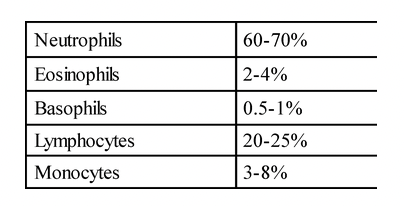Leucocytes/WBC's
Animal Tissues of Class 11
Leucocytes/WBCs
- Devoid of hemoglobin and so colourless.
- Divided into two main categories:
- Granulocytes (with cytoplasmic granules)
- Agranulocytes (without granules)
- Granulocytes are of three types - neutrophils, eosinophils and basophils. All have lobed nucleus.
- Agranulocytes are of two types - lymphocytes and monocytes usually with spherical nucleus.
- The total leucocyte count is 5000 / cubic mm of blood, ratio of RBC : WBC is 600 : 1.
- An increase in the number of WBCs is leucocytosis; abnormally low level of WBC is leucopenia.
- Differential leucocyte count (DLC) helps to diagnose an injury or infection in 100 WBCs.
Normal DLC is

Neutrophils are the most abundant and most active (rapid) type of WBC. Nucleus is 3-5 lobed connected by thin chromatin strands. They are phagocytic in nature. These engulf pathogens rapidly.
Eosinophils are non-phagocytic and possess bilobed nucleus, lobes being connected by isthmus. High eosinophil count indicates allergic conditions and parasitic infestations.
Basophils are non-phagocytic with 2-3 lobed nuclei. They are actively amoeboid and ingest particles like carbon. They are also involved in allergic reactions.
Lymphocytes are non-phagocytic, produced in the lymphatic tissue of the body which is present in spleen, lymph nodes, thymus, tonsils etc. They produce serum globulin (-and -globulins) which gives rise to antibodies and antitoxins. Lymphocytes play an important role in the immunological reactions to tissue transplantation.
Monocytes are the largest leucocytes and are phagocytic in nature. They originate from reticulo-endothelial system. They play a vital role in removing damaged tissue.
The life-span of WBCs in man is about 10-13 days.
The squeezing of WBCs through the walls of the capillaries in the infected area is called diapedesis.
WBC cannot undergo cell division.
Leukemia, also called ‘blood cancer’, is an uncontrolled production of leucocytes.
Thrombocytes/Blood Platelets
Protoplasmic discs found in mammalian blood. In lower vertebrates, they are spindle-shaped and called thrombocytes.
Blood platelets are nucleated cells, formed by the fragmentation of cells called ‘megakaryocytes’ from the bone marrow.
The number of blood platelets per cubic millimeter in human blood in 3 lacs.
The life span of blood platelets is 7-12 days.
Blood platelets are source of thromboplastin, necessary for blood clotting.
- Tissue
- Types of Animal Tissues
- Epithelial Tissue
- Covering and Lining Epithelium
- Glandular Epithelium
- Connective Tissue
- Skeletal Tissues
- Vascular Tissues
- Origin of Blood Cells
- Erythrocytes/RBC's
- Leucocytes/WBC's
- Blood Clotting
- Lymph
- Muscular Tissue
- Nervous Tissue
- Integument
- Exercise 1
- Exercise 2
- Exercise 3
- Exercise 4
- Exercise 5
- Exercise 6









